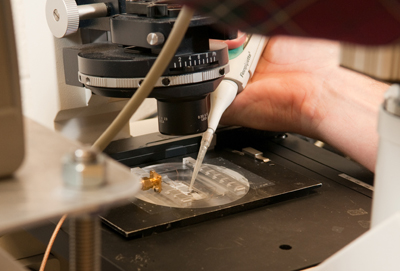|
|
Source: Bret Flanders, 785-532-1627, bret.flanders@phys.ksu.edu
Photos available. Contact media@k-state.edu or 785-532-6415.
Videos available: http://tinyurl.com/bjm42u and http://tinyurl.com/co4z3r
News release prepared by: Erinn Barcomb-Peterson, 785-532-6415, ebarcomb@k-state.edu
Thursday, Jan. 29, 2009

NEWS TIP: K-STATE PHYSICIST PART OF RESEARCH GROUP DEVELOPING ELECTROMECHANICAL PROBES TO HELP SCIENTISTS UNDERSTAND TISSUE-LEVEL PROCESSES LIKE WOUND HEALING
MANHATTAN -- The same crystallization process that makes snowflakes grow is helping a Kansas State University physicist and his fellow researchers develop tiny electromechanical probes for living cells. Delivering electrical stimuli to cells will help scientists understand tissue-level processes, such as how wounds heal.
 |
| Prem Thapa and Bret Flanders |
Bret Flanders, K-State associate professor of physics, is part of a research group that develops nanowire-based electromechanical probes of living cells. One of their goals is to measure the force exerted by cells during migration. The group recently developed a nanowire growth technique called Directed Electrochemical Nanowire Assembly, or DENA.
This technique borrows a form of crystallization, like that which makes snowflakes grow, to connect an electrode to a living cell in order to probe it with minimal damage to the cell. The group has expanded this technique to polymeric materials, which are gentler on the cells. The technique was featured Jan. 19 in Vol. 94 of Applied Physics Letters, http://tinyurl.com/blmu5v
Prem Thapa, K-State postdoctoral researcher in physics, was lead author. Flanders and other colleagues were co-authors.
The research, which was supported by the National Science Foundation, will appear online with the foundation's Discoveries features, http://www.nsf.gov/discoveries/